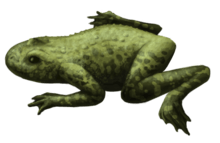Callobatrachus
| Callobatrachus Temporal range: Early Cretaceous, 125 Ma | |
|---|---|
 | |
| Artist's reconstruction | |
| Scientific classification | |
| Kingdom: | Animalia |
| Phylum: | Chordata |
| Class: | Amphibia |
| Order: | Anura |
| Family: | Discoglossidae |
| Genus: | †Callobatrachus Wang & Gao, 1999 |
| Species: | †C. sanyanensis |
| Binomial name | |
| Callobatrachus sanyanensis Wang & Gao, 1999 | |
Callobatrachus is an extinct genus of discoglossoid anuran amphibian from the Early Cretaceous-age Yixian Formation of Liaoning, China.[1] It was described in 1999 by K. Gao of the American Museum of Natural History and Y. Wang of the Chinese Academy of Sciences.[2] Discovered in the Sihetun locality of the western part of Liaoning province, in the lower part of the Yixian Formation, the fossil dates to approximately 124.6 Ma. Callobatrachus is considered to be the most basal member of Discoglossidae based on phylogenetic analysis.[1]
As frogs are rarely found as articulated skeletons in the fossil record, the discovery of this new taxon has provided important insight into anuran evolution.[3]
The holotype, IVPP V11525, is known from a nearly complete skeleton exposed in a dorsal view on a shale slab. Its total body length (from snout to vent) is estimated at approximately 94 mm.[4] It differs morphologically in many respects from all other discoglossoids, including the number of presacral vertebrae (9 instead of the usual 8) and other primitive characters. Although it had a mosaic of primitive and derived characters, it can be unequivocally placed as the most basal taxon of the clade. This shows that the taxon diverged early from the stem and evolved separately as a distinct lineage by the Early Cretaceous in East Asia.[1]
The skull is described as being short and wide and is well preserved. The maxillary region is less well-preserved but it can be determined that each premaxilla bears 18-20 slender and conical teeth, and the maxilla bears approximately 40-50 fine pedicellate teeth. The vertebral column consists of nine presacral vertebrae, a single sacral vertebra, and a free urostyle. Three pairs of ribs were found associated with presacrals II-IV. The hind limbs are remarkably well-preserved and are slenderly built, with an approximate total length of 116 mm. Its hind feet have the phalangeal formula 2-2-3-4-3, with its fourth digit being the longest at 27 mm.[4]
Before its description, Callobatrachus was announced in Chinese media as "sanyanlichan".[5]
See also
References
- 1 2 3 Yuan, W.; Keqin, G.; Xing, X. (2000). "Early evolution of discoglossid frogs: new evidence from the Mesozoic of China". Naturwissenschaften. 87: 417–420. doi:10.1007/s001140050753.
- ↑ Gao, Ke-Qin; Wang, Yuan (1999). "Earliest Asian discoglossid frog from western Liaoning". Chin Sci Bull. 44: 636–642.
- ↑ Pan, Gu (1999). "New advance in fossil anuran study". Chinese Science Bulletin. 44 (7): 589. doi:10.1007/bf03182713.
- 1 2 Gao, Ke-Qin; Wang, Yuan (2001). "Mesozoic anurans from Liaoning Province, China, and phylogenetic relationships of archaeobatrachian anuran clades". Journal of Vertebrate Paleontology. 21 (3): 460–476. doi:10.1671/0272-4634(2001)021[0460:maflpc]2.0.co;2.
- ↑ "China Yields East Asia's Earliest Fossilized Frog". English.peopledaily.com.cn. 2001-11-20. Retrieved 2013-06-03.
External links
- "Chinese frog discovery sheds light on amphibians' evolution" from ABC News Online
Category Prehistoric animals of China